Caveolin-1-deficient mice show defects in innate immunity and inflammatory immune response during Salmonella enterica serovar Typhimurium infection
- PMID: 16982844
- PMCID: PMC1698056
- DOI: 10.1128/IAI.00949-06
Caveolin-1-deficient mice show defects in innate immunity and inflammatory immune response during Salmonella enterica serovar Typhimurium infection
Abstract
A number of studies have shown an association of pathogens with caveolae. To this date, however, there are no studies showing a role for caveolin-1 in modulating immune responses against pathogens. Interestingly, expression of caveolin-1 has been shown to occur in a regulated manner in immune cells in response to lipopolysaccharide (LPS). Here, we sought to determine the role of caveolin-1 (Cav-1) expression in Salmonella pathogenesis. Cav-1(-/-) mice displayed a significant decrease in survival when challenged with Salmonella enterica serovar Typhimurium. Spleen and tissue burdens were significantly higher in Cav-1(-/-) mice. However, infection of Cav-1(-/-) macrophages with serovar Typhimurium did not result in differences in bacterial invasion. In addition, Cav-1(-/-) mice displayed increased production of inflammatory cytokines, chemokines, and nitric oxide. Regardless of this, Cav-1(-/-) mice were unable to control the systemic infection of Salmonella. The increased chemokine production in Cav-1(-/-) mice resulted in greater infiltration of neutrophils into granulomas but did not alter the number of granulomas present. This was accompanied by increased necrosis in the liver. However, Cav-1(-/-) macrophages displayed increased inflammatory responses and increased nitric oxide production in vitro in response to Salmonella LPS. These results show that caveolin-1 plays a key role in regulating anti-inflammatory responses in macrophages. Taken together, these data suggest that the increased production of toxic mediators from macrophages lacking caveolin-1 is likely to be responsible for the marked susceptibility of caveolin-1-deficient mice to S. enterica serovar Typhimurium.
Figures
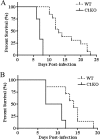
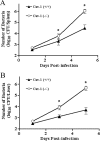
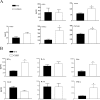

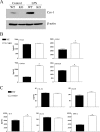
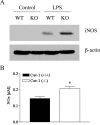

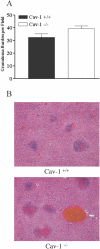

Similar articles
-
Toll-Like receptor 2 (TLR2) and TLR9 play opposing roles in host innate immunity against Salmonella enterica serovar Typhimurium infection.Infect Immun. 2015 Apr;83(4):1641-9. doi: 10.1128/IAI.02870-14. Epub 2015 Feb 9. Infect Immun. 2015. PMID: 25667264 Free PMC article.
-
Murein lipoprotein is a critical outer membrane component involved in Salmonella enterica serovar typhimurium systemic infection.Infect Immun. 2005 Feb;73(2):1081-96. doi: 10.1128/IAI.73.2.1081-1096.2005. Infect Immun. 2005. PMID: 15664952 Free PMC article.
-
Proteins from latex of Calotropis procera prevent septic shock due to lethal infection by Salmonella enterica serovar Typhimurium.J Ethnopharmacol. 2010 Jun 16;129(3):327-34. doi: 10.1016/j.jep.2010.03.038. Epub 2010 Apr 3. J Ethnopharmacol. 2010. PMID: 20371281
-
Critical role of type I interferon-induced macrophage necroptosis during infection with Salmonella enterica serovar Typhimurium.Cell Mol Immunol. 2013 Mar;10(2):99-100. doi: 10.1038/cmi.2012.68. Epub 2012 Dec 24. Cell Mol Immunol. 2013. PMID: 23262973 Free PMC article. Review. No abstract available.
-
Salmonella and the Inflammasome: Battle for Intracellular Dominance.Curr Top Microbiol Immunol. 2016;397:43-67. doi: 10.1007/978-3-319-41171-2_3. Curr Top Microbiol Immunol. 2016. PMID: 27460804 Review.
Cited by
-
Animal models of systemic sclerosis: their utility and limitations.Open Access Rheumatol. 2014 Jul 1;6:65-81. doi: 10.2147/OARRR.S50009. eCollection 2014. Open Access Rheumatol. 2014. PMID: 27790036 Free PMC article. Review.
-
Caveolin-1 promotes glioma progression and maintains its mitochondrial inhibition resistance.Discov Oncol. 2023 Aug 29;14(1):161. doi: 10.1007/s12672-023-00765-5. Discov Oncol. 2023. PMID: 37642765 Free PMC article.
-
Caveolin-2-deficient mice show increased sensitivity to endotoxemia.Cell Cycle. 2011 Jul 1;10(13):2151-61. doi: 10.4161/cc.10.13.16234. Epub 2011 Jul 1. Cell Cycle. 2011. PMID: 21670588 Free PMC article.
-
Caveolae and Caveolin-1 Integrate Reverse Cholesterol Transport and Inflammation in Atherosclerosis.Int J Mol Sci. 2016 Mar 22;17(3):429. doi: 10.3390/ijms17030429. Int J Mol Sci. 2016. PMID: 27011179 Free PMC article. Review.
-
Caveolin-Mediated Endocytosis: Bacterial Pathogen Exploitation and Host-Pathogen Interaction.Cells. 2024 Dec 24;14(1):2. doi: 10.3390/cells14010002. Cells. 2024. PMID: 39791703 Free PMC article. Review.
References
-
- Catron, D. M., M. D. Sylvester, Y. Lange, M. Kadekoppala, B. D. Jones, D. M. Monack, S. Falkow, and K. Haldar. 2002. The Salmonella-containing vacuole is a major site of intracellular cholesterol accumulation and recruits the GPI-anchored protein CD55. Cell Microbiol. 4:315-328. - PubMed
-
- Centers for Disease Control and Prevention. 1999. Summary of notifiable diseases, United States, 1998. Morb. Mortal. Wkly. Rep. 47:ii-92. - PubMed
-
- Chan, S. Y., C. J. Empig, F. J. Welte, R. F. Speck, A. Schmaljohn, J. F. Kreisberg, and M. A. Goldsmith. 2001. Folate receptor-alpha is a cofactor for cellular entry by Marburg and Ebola viruses. Cell 106:117-126. - PubMed
Publication types
MeSH terms
Substances
Grants and funding
LinkOut - more resources
Full Text Sources
Medical
Molecular Biology Databases

